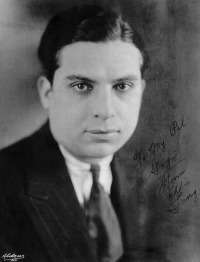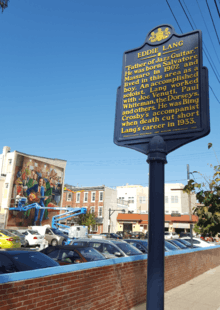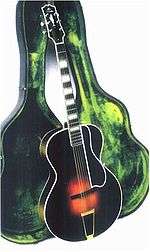Eddie Lang
| Eddie Lang | |
|---|---|
 | |
| Background information | |
| Birth name | Salvatore Massaro |
| Also known as | Blind Willie Dunn |
| Born |
October 25, 1902 Philadelphia, Pennsylvania, U.S. |
| Died |
March 26, 1933 (aged 30) New York City, U.S. |
| Genres | Jazz, chamber jazz |
| Occupation(s) | Musician |
| Instruments | Guitar |
| Years active | 1918–1933 |
| Labels | Okeh |
| Associated acts | Joe Venuti, Lonnie Johnson, Paul Whiteman, Bing Crosby |
| Notable instruments | |
| Gibson L-4, Gibson L-5 | |
- For the blues singer, see Eddie Lang (singer)
Eddie Lang (October 25, 1902 – March 26, 1933) was an American musician regarded as the father of jazz guitar.[1] He displaced the banjo with the guitar and made it a worthy solo and band instrument.[2]
Biography

Lang was born Salvatore Massaro in Philadelphia, the son of an Italian-American[3] instrument maker.[4] He learned violin at the age of seven, soon adding guitar and banjo. Within a year he was playing all three professionally and in public. In the early 1920s he played with Vic D'Ipplito, Bert Estlow, Charlie Kerr, Bill Lustin's Scranton Sirens, and Red McKenzie's Mound City Blue Blowers. During the 1920s he recorded and performed on radio, often with violinist Joe Venuti, a friend since both were children; with Jean Goldkette, Roger Wolfe Kahn , Adrian Rollini, Frankie Trumbauer, Paul Whiteman; and with guitarists Lonnie Johnson, Carl Kress, and Dick McDonough.[2] Lang used the pseudonym Blind Willie Dunn to hide his race when he played at venues with Johnson, a black blues musician.[2][4][5]
In 1929, Lang joined Paul Whiteman's Orchestra. The following year he recorded the song "Georgia on My Mind" with Hoagy Carmichael, Joe Venuti, and Bix Beiderbecke. He became a regular in Bing Crosby's orchestra in 1932. He also appeared briefly in two movies: King of Jazz (1930) and The Big Broadcast (1932).[2]
In 1933, at the age of thirty, Lang died following a tonsillectomy.[6] Bing Crosby had urged Lang to have the operation so he could have speaking parts in Crosby's movies. Lang's voice was chronically hoarse. The cause of his death is uncertain. Author James Sallis claims that Lang developed an embolism while under anesthetic and never regained consciousness.[7]
Influence

While most bands of the time had a banjo player (the banjo being louder than the guitars of the time), Lang was skilled enough to make his acoustic guitar heard in the mix. He was so influential that, according to George Van Eps, banjo players had no choice but to switch to guitar.[5]
Van Eps said, "It's very fair to call Eddie Lang the father of jazz guitar." Barney Kessel: "Eddie Lang first elevated the guitar and made it artistic in jazz." Les Paul: "Eddie Lang was the first and had a very modern technique." Joe Pass, in a 1976 interview, stated that Lang was one of the three main guitar innovators, with Wes Montgomery and Django Reinhardt.
Lang played a Gibson L-4 and L-5 guitar, influencing guitarists such as Django Reinhardt.[8]
Honors
In 1977, Lang's recording of "Singin' the Blues" with Frankie Trumbauer and Bix Beiderbecke, was inducted into the Grammy Hall of Fame and in 2006 was placed on the U.S. Library of Congress National Recording Registry.
He was inducted into the ASCAP Jazz Wall of Fame (1986) and the Big Band and Jazz Hall of Fame (2010).[9]
On October 23, 2016, Philadelphia's Mural Arts organization dedicated the mural, Eddie Lang: The Father of Jazz Guitar, by artist Jared Bader. The mural stands by Lang's childhood home and the James Campbell School that stood at 8th and Fitzwater where Lang learned to play.[10]
The mural was made possible by the suggestion of local guitarist Richard Barnes , who has campaigned for it since 2010 when he started "Eddie Lang Day in Philadelphia" , an annual music/charity event , made official by a Mayoral proclamation in 2010 by Mayor Michael Nutter.
http://eddielangdayinphiladelphia.blogspot.com/
Compositions
Lang's compositions, based on the Red Hot Jazz database, include Wild Cat with Joe Venuti, Perfect with Frank Signorelli, April Kisses, Sunshine, Melody Man's Dream, Goin' Places, Black and Blue Bottom, Bull Frog Moan, Rainbow Dreams, Feelin' My Way, Eddie's Twister, Really Blue, Penn Beach Blues, Wild Dog, Pretty Trix, A Mug of Ale, Apple Blossoms, Beating the Dog, To To Blues, Running Ragged, Kicking the Cat, Cheese and Crackers, Doin' Things, Blue Guitars, Guitar Blues with Lonnie Johnson, Hot Fingers, Have to Change Keys to Play These Blues, A Handful of Riffs, Blue Room, Deep Minor Rhythm Stomp, Two-Tone Stomp. Midnight Call Blues, Four String Joe, Goin' Home, and Pickin' My Way with Carl Kress.[11]
Discography
Singles
| Song | Musicians | Recording date | Label |
|---|---|---|---|
| Stringin' the Blues | Joe Venuti | November 8, 1926 | |
| Hurricane | Red Nichols and His Five Pennies | January 12, 1927 | |
| Wild Cat | Joe Venuti | January 24, 1927 | Okeh |
| Sunshine | Joe Venuti | January 24, 1927 | Okeh |
| Singin' the Blues | Bix Beiderbecke, Frankie Trumbauer | February 4, 1927 | Okeh |
| April Kisses b/w Eddie's Twister | April 1, 1927 | Okeh | |
| Doin' Things | Joe Venuti | May 4, 1927 | |
| Goin' Places | Joe Venuti | May 4, 1927 | |
| For No Reason at All in C | Bix Beiderbecke, Frankie Trumbauer | May 13, 1927 | Okeh, Columbia, Parlophone |
| Beating the Dog | Joe Venuti, Adrian Rollini | June 28, 1927 | Okeh |
| Wringin' an' Twistin' | Bix Beiderbecke, Frankie Trumbauer | September 17, 1927 | OKeh |
| Perfect | Frank Signorelli | October 21, 1927 | Okeh |
| Four String Joe | Joe Venuti's Blue Four | November 15, 1927 | |
| Guitar Blues | Lonnie Johnson | May 7, 1929 | Okeh |
| Knockin' a Jug | Louis Armstrong, Jack Teagarden | March 5, 1929 | |
| Kitchen Man | Bessie Smith | May 8, 1929 | |
| A Bench in the Park | Paul Whiteman and His Orchestra | March 21, 1930 | |
| Georgia on My Mind | Hoagy Carmichael, Bix Beiderbecke | September 15, 1930 | Victor |
| Pickin' My Way | Carl Kress | January 15, 1932 | Brunswick |
| Feelin' My Way | Carl Kress | January 17, 1932 | Brunswick |
| Please | Bing Crosby | September 16, 1932 | |
| Jigsaw Puzzle Blues | Joe Venuti, Eddie Lang's Blue Five | February 28, 1933 |
Albums
- The 1920s and 1930s Sides by Joe Venuti and Eddie Lang (JSP)
- Eddie Lang, Carl Kress, and Dick McDonough (Retrieval)
- Fiddelsticks by the Venuti-Lang All-Star Orchestra (Conifer)
- Stringing the Blues (Koch, 2000)
- The Classic Columbia and Okeh Joe Venuti and Eddie Lang (Mosaic, 2002)[2]
Bibliography
- Peters, Mike. The Classic Columbia and Okeh Joe Venuti and Eddie Lang Sessions. Notes by Mike Peters, Marty Grosz, Richard M. Sudhalter, Scott Wenzel. Mosaic Records, 2002.
- Mazzoletti, Adriano. Eddie Lang: Stringin' the Blues. Rome, Italy: Pantheon Editore, 1997.
- Sallis, James, editor. Jazz Guitar: An Anthology. Quill Publishers, 1984.
- Worsfold, Sally-Ann. The Quintessential Eddie Lang, 1925–1932. Timeless Records, 1997.
- Berend, Dave. Seven Original Compositions for the Guitar by the Great Eddie Lang: Transcribed and Arranged for Plectrum Guitar Solos with Guitar Accompaniment. Robbins Music, 1961.
References
- ↑ Ferguson, Jim (1983). Father of Jazz Guitar. GPI Publications. pp. 78–86.
- 1 2 3 4 5 Yanow, Scott (2003). Jazz on Record. San Francisco, Calif.: Backbeat. p. 94. ISBN 0-87930-755-2.
- ↑ Lang's father was born in Monteroduni, an Italian village in Molise. The township of Monteroduni hosts every year a commemorative Eddie Lang Jazz Festival. See
- 1 2 Lyttelton, Humphrey (1998). The Best of Jazz. Robson Books. pp. 139–140. ISBN 1-86105-187-5.
- 1 2 Obrecht, Jay (December 2015). "The Lonnie Johnson-Eddie Lang Duets". Guitar Player. pp. 26–30, 140.
- ↑ Jazz and Otolaryngology: The Death of Guitarist Eddie Lang
- ↑ The Guitar Players – One Instrument and Its Masters in American Music by James Sallis 1982
- ↑ Berendt, Joachim E (1976). The Jazz Book. Paladin. p. 268.
- ↑ 2010 ASCAP Jazz Wall of Fame Inductees.
- ↑ Farnsworth, Taylor (October 19, 2016). "Eddie Lang mural installed at 7th and Fitzwater, to be dedicated on Sunday". Passyunk Post. Retrieved 2016-10-19.
- ↑ Eddie Lang at RedHot Jazz